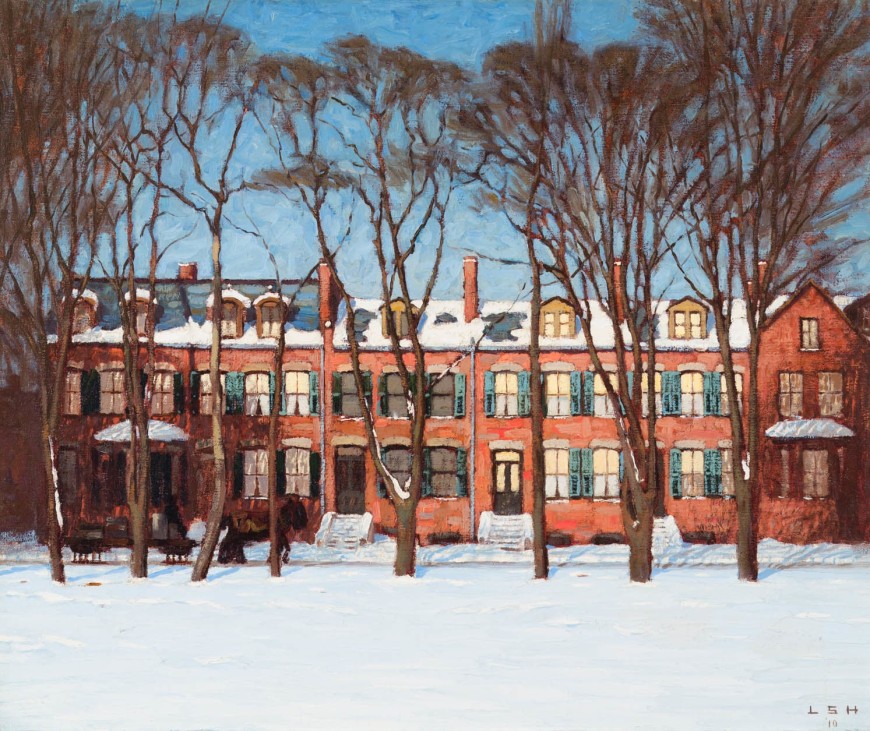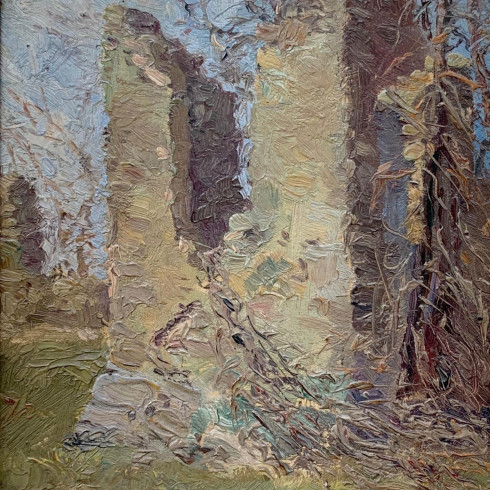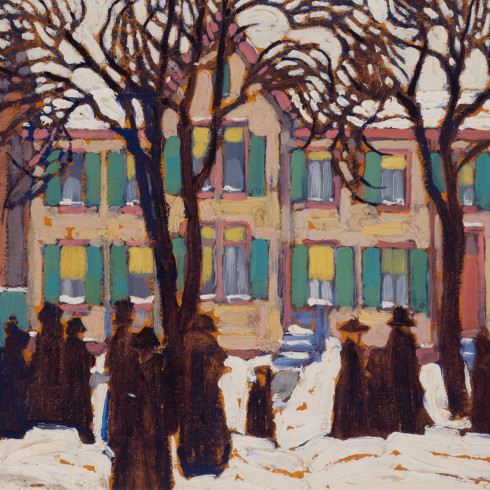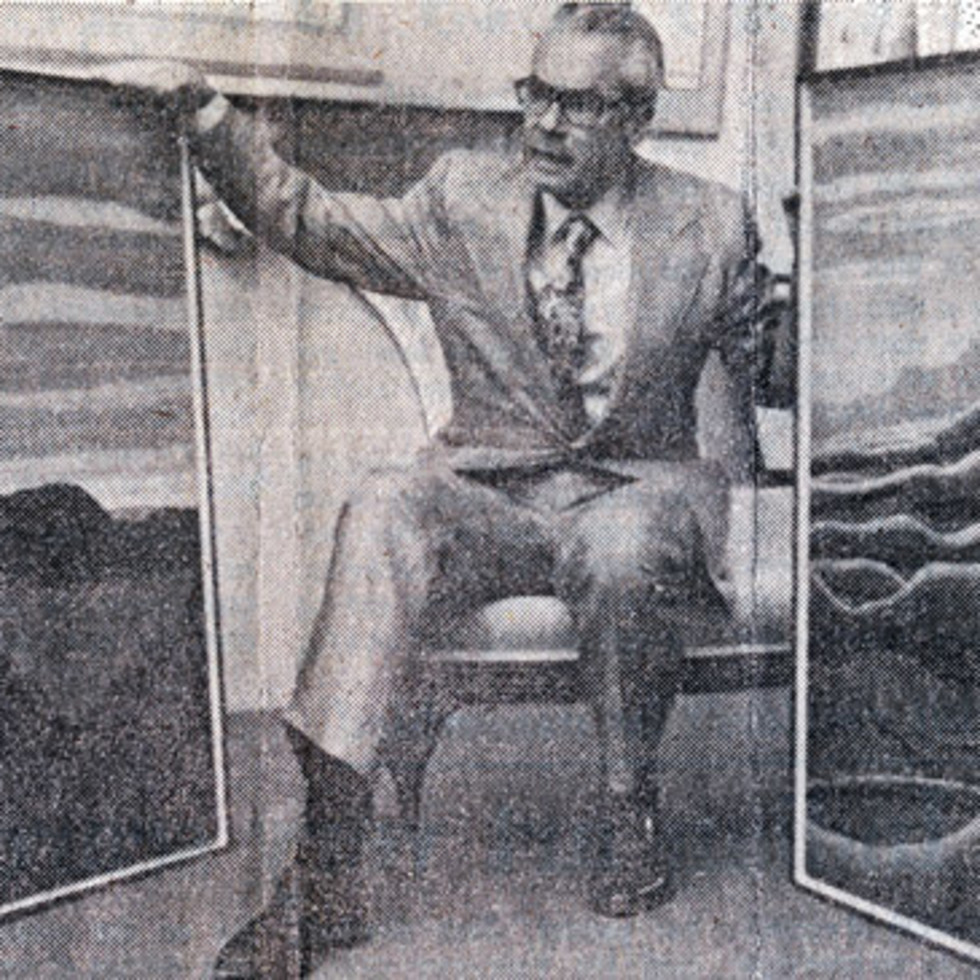Ventes notoires
A Row of Houses, Wellington Street (Street Painting I), 1910
63.5 x 76.2 cm
Provenance
The Artist;
Bess Harris (Mrs. Lawren S. Harris);
L.S.H. Holdings, Ltd.
Laing Galleries, Toronto.
The Art Emporium, Vancouver.
The Collection of Mitzi and Mel Dobrin.
Expositions
Toronto, Ontario Society of Artists, 39th Exhibition, 1911, no. 88.
Toronto, Canadian National Exhibition, 1911, no. 137.
Winnipeg, Royal Canadian Academy Exhibition, 1912, no. 79.
Toronto, Retrospective Loan Exhibition of the Works of Members of the Ontario Society of Artists, 1922, no. 77.
Toronto, Art Gallery of Toronto, Lawren Harris Paintings, 1910-1948, 1948, no. 1.
Ottawa, National Gallery of Canada, Lawren Harris Retrospective Exhibition, June 7 - September 8, 1963, no. 1
Ottawa, National Gallery of Canada, The Group of Seven / Le Groupe des Sept, June 19 - September 8, 1970, no. 23.
Toronto, Art Gallery of Ontario, Lawren S. Harris: Urban Scenes and Wilderness Landscapes, 1906-1930, January 14-February 26, 1978, no. 17.
Toronto, Alan Klinkhoff Gallery, Lawren Harris & Canadian Masters: Historic Sale Celebrating Canada's 150 Years, April 1- April 30, 2017.
Documentation
Notes on Pictures at the O.S.A. Exhibition [1911], n.p..J. Russell Harper, Painting in Canada: A History, Toronto: University of Toronto Press, 1969, repr. in colour, p. 271.
Bess Harris and R.G.P. Cosgrove, eds., Lawren Harris, Toronto: Macmillan of Canada, 1969, repr. in colour, pl. 136.
Dennis Reid, The Group of Seven/Le Groupe des Sept, Ottawa: The National Gallery of Canada, 1970, p. 56, repr. pl. 23.
Peter Cummings, "Vancouver: Lawren Harris, The Art Emporium, November 1-23, 1976," Artscanada 33:4 (December 1976 - January 1977), repr. p.60.
Jeremy Adamson, Lawren S. Harris: Urban Scenes and Wilderness Landscapes, 1906-1930, Toronto: Art Gallery of Ontario, 1978, p. 29; 31, repr. pl. 27.
Peter Larisey, S.J., Light for a Cold Land: Lawren Harris’s Work and Life — An Interpretation, Toronto & Oxford: Dundurn Press, 1993, pp. 22-23.
John Murray, Lawren Harris: An Introduction to His Life and Art, Toronto: Firefly Books, 2003, p. 15-16, repr. in colour, p. 17.
David Silcox, The Group of Seven and Tom Thomson, Toronto: Firefly Books, 2003, repr. in colour. 137.
Paul Duval, Lawren Harris: Where the Universe Sings, Toronto: Cerebrus Publishing, 2011, p. 50, repr. in colour, p. 51.
Jason McBride, "The Mystic," Toronto Life Magazine, (July, 2016), p. 48, repr. in color, p. 49.
Le texte complet portant sur cette oeuvre n'est disponible qu'en anglais seulement. Nous vous remercions de votre compréhension.
Pour obtenir davantage de renseignement, nous vous encourageons à communiquer avec nous.
A Row of Houses, Wellington Street is Lawren Harris’ first major canvas depicting downtown Toronto housing. Signed and dated “L S H ’10” on the face of the picture, a faint inscription on the back of the original stretcher, retained and now attached to the current one reads “Street Painting I.” The site can be identified. On the city’s 1880 fire insurance map, the row of six adjoined, two-and-half story brick dwellings was named “St Catharine’s Terrace” and was located on the north side of Wellington Street West between Dorset and John Streets. The units appear on later maps of St. Andrew’s Ward though 1910. On the adjacent block to the west, only wooden row housing and individual brick structures were constructed, while the 1879 terraced brick housing built on the north side of Clarence Square further to the west were all uniform in architectural style, each with a mansard roof and projecting bay. The original houses were erected in a fashionable neighbourhood, adjacent to the spacious grounds of the old Provincial Parliament Buildings, the elegant Second Empire-style Government House and to the north, Upper Canada College. However, by 1910 the school had moved to its current site and the 1832 legislature had been demolished and replaced by the rail yards of the Grand Trunk Railway. Five years later, both Government House and Harris’ row of six houses had themselves been torn down for further railroad expansion. Nonetheless, in 1910 the dwellings were solidly middle class, unlike the substandard buildings which housed poor, working-class immigrants living in “the Ward” a few blocks to the north in the rundown neighbourhood Harris focused his attention on afterwards. He was drawn to seedy urban areas as a student in Berlin during 1903-07, sketching dreary slum housing. A Row of Houses, Wellington Street established the layered compositional format Harris would employ for the majority of his Toronto house pictures painted in the 1910s and early 1920s. The facades of these residences are placed parallel to the picture plane and, like many of his later oil sketches and paintings, are fronted by city street trees that provide tall, vertical elements that integrate the zone of the sky with that of the buildings below. Like the Post-Impressionist art he had admired as a student in Europe, Harris deliberately flattened there picture’s overall design and simplified the representational components. The brushwork is emphatic: the architectural details are “constructed” with individual strokes, while the bare tree branches and blue sky beyond are part of an energetic web of irregular strokes. A horse-drawn sleigh is visible behind tree trunks on the left, but there is no human action in the picture: the buildings and their physical setting remain the material subject. However, Harris imbued his picture with extra-aesthetic meaning. When it was first exhibited in the 1911 Ontario Society of Artists show, it was accompanied by another of his early Toronto streetscapes, Along Melinda Street. In the official pamphlet accompanying the exhibition, the artist described his intentions in the Wellington Street picture: “the endeavour was to depict the clear, hard sunlight of a Canadian noon in winter. An attempt was also made to suggest the spirit of old York [Toronto].” By contrast, Along Melinda Street was a dark, dramatic winter composition that aimed “to suggest the movement of a snow storm — the way it swirls around things and gets into every nook and opening. . . .” In both pictures, the subject is a Canadian winter — an early, if implicit, indication of the centrality of the North in his art. Moreover, by evoking “the spirit of old York” in A Row of Houses, Wellington Street, he further confirmed his newfound enthusiasm for local, specifically Canadian subject matter. According to his wife Bess, when Harris finally settled back in Toronto in 1909, “the quality and clarity of the light excited him.” This is clearly evident in the brilliantly lighted field of snow in the large foreground zone. However, the crisp sunshine of a winter noon does not illuminate the houses in the middle distance. The patchy light that plays over the facades is more poetic in character, helping to animate the scene and to guide the viewer’s visual experience of the picture. The first of a long line of major urban scenes by Lawren Harris, A Row of Houses, Wellington Street is historically significant not only as the original of a series, but as the artist’s earliest public expression of his commitment to the look and feel of Canada in his art.
Jeremy Adamson, PhD From Lawren Harris & Canadian Masters, Alan Klinkhoff Gallery, 2017
Jeremy Adamson, PhD served as a curator of historical Canadian art at the Art Gallery of Ontario and the National Gallery of Canada. In 1978 he organized the exhibition Lawren S. Harris: Urban Scenes and Wilderness Landscapes, 1906—1930 and wrote the accompanying catalogue. After leaving Canada, he was senior curator at the Renwick Gallery of the Smithsonian American Art Museum and Chief of the Prints and Photographs Division at the U.S. Library of Congress. He recently retired from the Library as Director for Collections and Services.










